Chris & Allyson vs. Alaska (2016)
Chapter Eight: Denali.
You may remember that part in a Jack London book where a guy -- or maybe it was a dog -- felt the uncontrollable urge to murder something, or pee in the woods, or die in a snowstorm. This is known as the "call of the wild," or perhaps "gold fever," or "the old 23 skidoo of the north." We can all agree that being forced to read that book was a valuable part of our childhoods, and that its lessons stuck with us forever. Our visit to Alaska had featured a cruise ship, quaint small cities, and the sprawling strip-mall metropolis known as Anchorage. We had seen some nature, but we hadn't been totally surrounded by it. And if you're paying to go all the way to Alaska, at least once during your trip you should want to strip naked, tackle a moose and howl at the moon.
Alaska has plenty of wild places to visit, but most of them are extremely deadly or hard to reach. There is one, however, that is famous, seasonally survivable and reachable by rental car. On the 13th day of our vacation we started the final leg of our vacation by snagging supplies, packing the car and driving north to Denali.
The mountain formerly known as McKinley is the tallest in North America, at more than 20,300 feet. It's in the creatively named Alaska Range, and if everything is going your way, you can see it from Anchorage. It looks a lot like a mountain in a Bob Ross painting, because it IS the mountain in every Bob Ross painting. Bob spent a bunch of time in Alaska with the Air Force, so that's where he learned what almighty mountains look like.
Visitors come to see the mountain, but they stay for the surroundings. Early in the 20th century, there were lots of well-to-do white guys with a jones for nature. Some of them enjoyed pristine landscapes, while others enjoyed shooting nature's many citizens. Charles Sheldon supposedly liked both; he wanted to protect the habitat of Dall sheep, so there would be more of them to kill in the future. He convinced the government to set aside the lands around the mountain as a national park and preserve, effective in 1917. Since there were only five other white people in that part of Alaska at the time, it seemed like a harmless request. The park has grown over the years, with parcels of it getting special "wilderness" designation forbidding almost all commercial and recreational uses. It's only the third-largest national park in Alaska -- but it's still the size of Massachusetts. Lamentably, unlike Massachusetts, it has zero Dunkin' Donuts franchises. But it's still pretty impressive.
It was a 240-mile drive to the park entrance, but road-tripping in Alaska is mostly defined by the scarcity of roads. In highway speak, we took the 1 to the 3, and that was it. A quick glance at the map shows Alaskan highways numbered high as 10, but there's a good chance that some of those roads are just slightly trodden earth dotted with the bodies of prospectors from the 1890s. If you're taking a turnoff in Alaska, it's probably into the hidden entrance of the four-mile driveway that leads to the cabin where you've been murdering prostitutes the last 23 years. This might seem like a harsh judgment, but radio reception in Alaska is spotty -- and the channels are top 40, Elton-John-heavy classic rock, Christian or country. So we spent a lot of the drive listening to "Ice and Bone: Tracking an Alaskan Serial Killer." Allyson usually picks up a few audio books for any vacation, and there is no better way to learn about the place you're visiting than hearing tales of its most deranged psychos.
Once you pass Wasilla (of Sarah Palin fame) there's not much to see. The gas stations are few and far between, you'd miss the few towns if you blinked, and the road cuts through non-descript forests. You're climbing steadily, but it's not a particularly stunning climb. We did stop briefly to look at a moose, hidden in the woods by the side of the road. My wife wears a contact lens that blinds her left eye, and glasses to correct the vision of the right eye. She's still better at spotting wildlife than me. It was the first moose we had seen in the wild, and we charmingly thought it might be the only one we'd see, so we took a moment to enjoy it.
Our other stop was to spy on the mountain. The state government has its own Denali Park, which includes a bunch of trails and two rest stops. At the southern rest stop, we hopped out of the car and looked across a river plain at the Alaska Range. Even dozens of miles away, it was filling the horizon. And peeking out from some distant clouds was Denali itself, snow-covered and imposing in the middle of July. We charmingly thought that we'd see the mountain plenty more times, so after a few minutes we hopped back in the car to finish the journey.
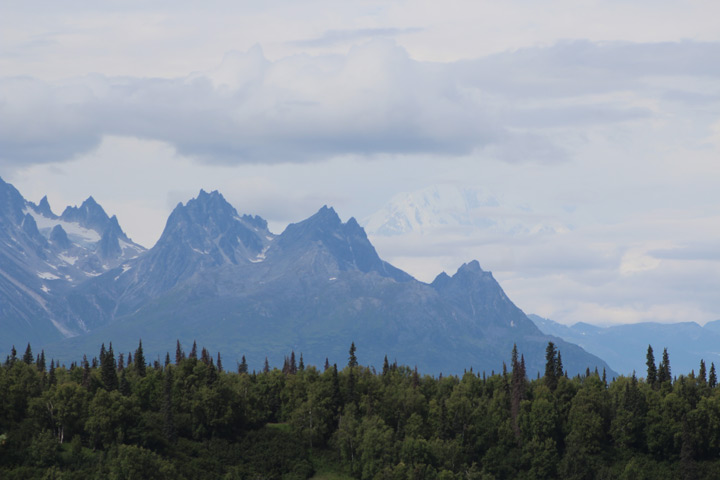
Although we didn't know it at the time, our best view of Denali was on the drive north.
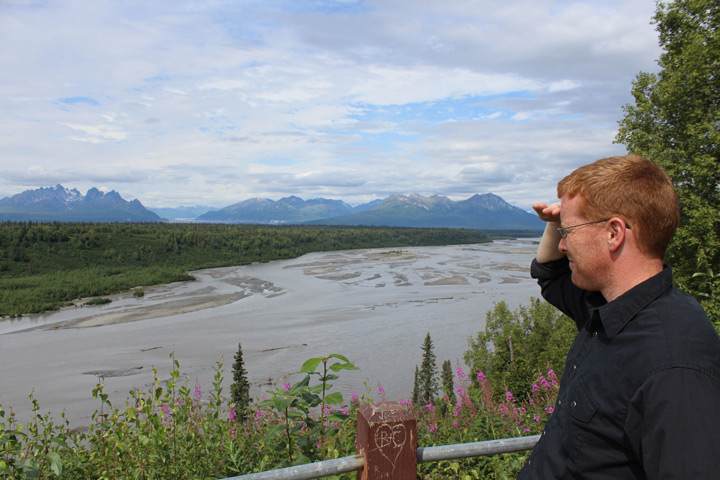
The overlook at the state-run Denali Park. A nice view, sometimes.
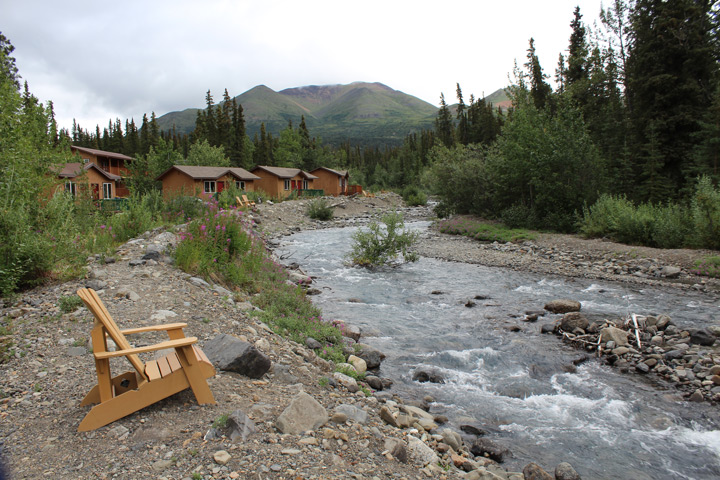
The "creekside" in McKinley Creekside Cabins.
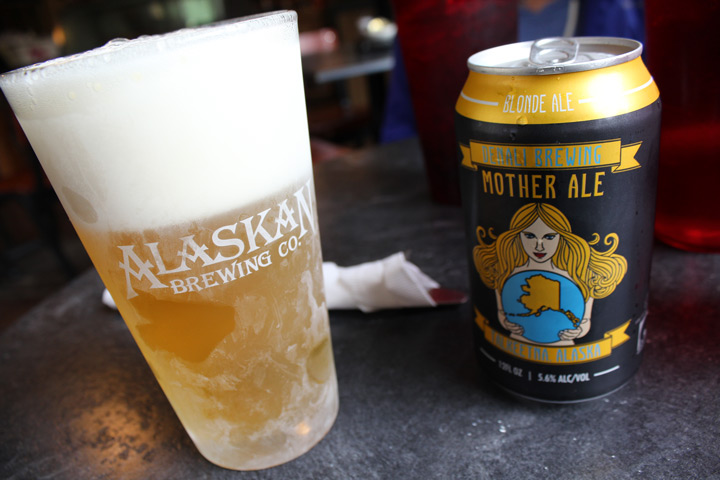
It would be insulting to the locals if you didn't drink their beer, right?
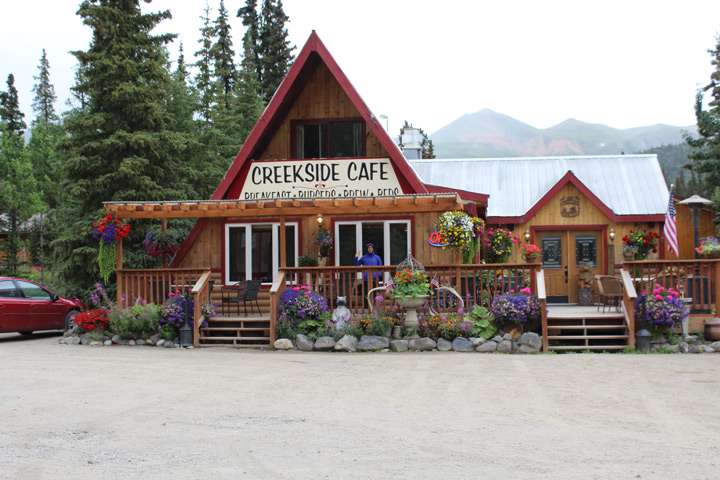
Our own personal Denali base camp.
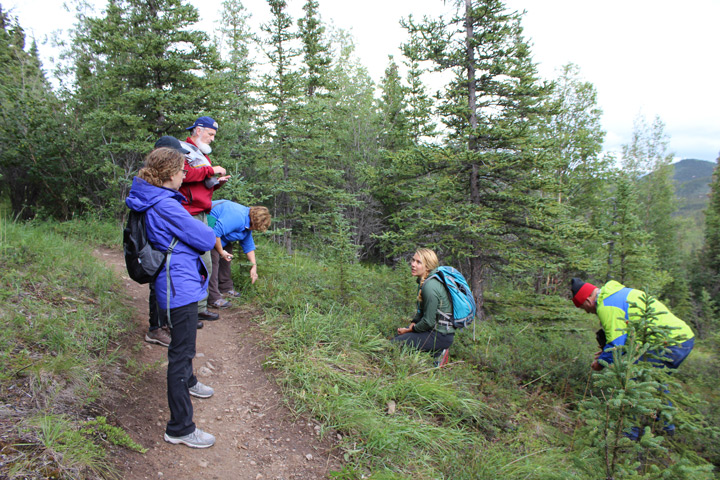
Stretching our legs on the Triple Lake Trail.
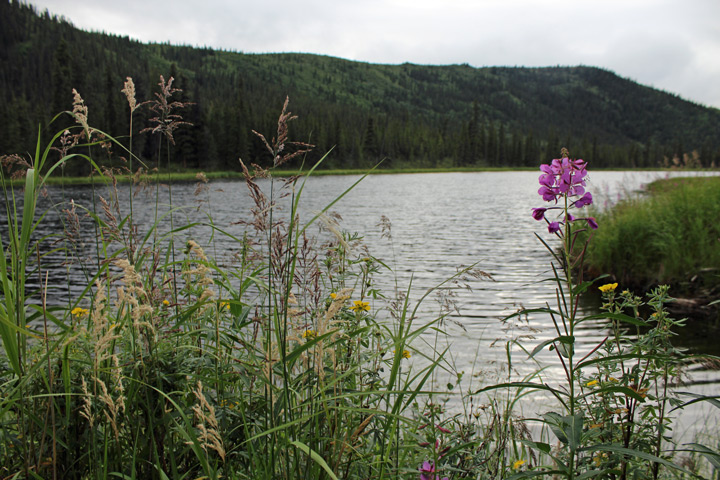
Wild Alaska, within the borders of Denali National Park.
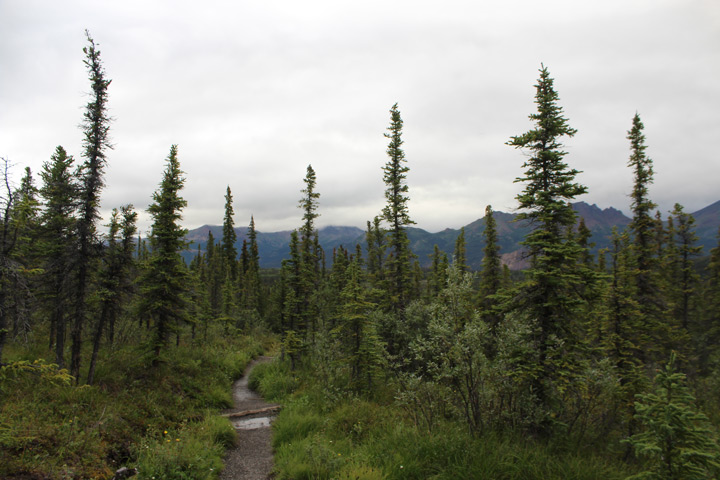
A typical view for the Triple Lake Trail.
A little before 4 p.m. we reached our home for the next few days: McKinley Creekside Cabins. The name says it all. There's a creek, and some cabins. They're beside the creek. We booked room number 9, in a cute little duplex cabin. It had a bedroom that was maybe 10x10 and a bathroom. There's no TV, and in that part of Alaska cell phone service is at the mercy of the universe. It's really everything you need when visiting Denali, because if you're sitting in a hotel room during your stay, you're doing it wrong. From inside the room, you could hear Carlo Creek babbling past, maybe 40 feet away. There was delightful lounge furniture by the water, and we would have sat there to enjoy it if the weather was dry or above 55 degrees.
A quick word on the weather at Denali: It's weird. In theory, temperatures can reach the 70s or 80s in mid-summer. We were stuck in the mid-50s for our entire visit, with the temperature dipping into the low 40s overnight. There's also a lot of moisture. When weather systems move across the Alaskan landmass, they stack up on the four-mile-tall mountain range. That works like a multi-car pileup on the highway, so the weather can change in an instant. Clouds roll in and out constantly; rain can be torrential or drizzly; and you can go from sunny and warm to snowing and deadly within 30 minutes. Of course, it routinely hits 40 below in the winter, so why complain?
After populating the cabin, we stopped into the "lodge," which has the hotel office and the adorable Creekside Cafe. They have a hard-working kitchen serving up three meals a day, plus whatever beers happen to be in stock that day. We grabbed a table by the window -- it would end up being our table about four more times -- and tanked up for the official tourism activity of the day. There's not much to do in Denali outside of seeing the park, and we didn't want to waste seven hours of daylight. After all, there are only 19 in a day.
Our pre-booked plan was to go for a walk. A van pulled up to the Creekside Cafe, picked us up and whisked us toward the park entrance. But instead of going all the way to the main gate, we parked on a shoulder, hopped out and picked up the Triple Lake Trail. We crossed into the park on foot. Our companions for this guided nature walk were an older couple from Southern California, and another older couple from Gettysburg, where the guy had an Abe Lincoln beard.
Our guide was Emily. Originally from Virginia, she said she split her time between Montana and Alaska, bouncing back and forth with her boyfriend. She lived in a cabin with no running water, spent all her free time climbing mountains, and had legs muscular enough to pull off all that Famke Janssen stuff from "Goldeneye." I don't know exactly what the career path is for the Emilys of the world, but it probably involves opening your own tour company, directing an Outward Bound program or getting mauled to death by a bear. I'm pretty confident she could kill me in unarmed combat, in less than a minute.
Emily started out a little bit disinterested. When you climb 3,000-foot peaks on your day off, it has to be tedious to babysit people who get winded walking to the refrigerator. But the point of this adventure was for her to tell us about the natural wonders of Denali. The trail even cut through a part of Denali’s designated "wilderness" area, where human activity is mostly limited to walking around and looking at things. Once Emily started dropping knowledge, it turned into a very good time. Some highlights:
You can eat a lot of stuff in Denali, and most of it won't kill you. We walked 1.5 miles into the park at a leisurely pace. The trail was lined almost the entire way with berries, and we got the go-ahead to eat most of them. There were blueberries, salmonberries and raspberries, all of which were delightful. Soapberries tasted nasty, but you can't die from eating them. Berries are the primary calorie source for bears, who need to put on a lot of weight very quickly to survive the winter. Their secondary calorie source is the dead bodies of hikers who were dumb enough to eat mushrooms, several varieties of which CAN kill you. Hearing all this information led to an interesting discussion about Chris McCandless, the itinerant "hero" of "Into the Wild." McCandless was a well-off white guy from Virginia with a slightly problematic home life. Not long after college he decided to go off the grid and roam the American west. He came to envision Alaska as the crucible that would burn off the last of his tainted materialistic past. With very little training or equipment, he walked into the wilderness not far from Denali. A few months later he was found dead in an abandoned bus that was sometimes used by hunters as a shelter. With him was a journal containing cursory descriptions of his activities leading up to his death. Author John Krakauer used that journal to create a highly speculative account of McCandless' final adventure, the aforementioned “Into the Wild.” It was later turned into a movie, directed by Sean Penn. McCandless is an iconic figure and a controversial one. Lots of non-Alaskans view him as a romantic hero, struggling to find his true self. Lots of Alaskans view him as a moron who died needlessly, because he learned nothing about respecting the wilderness. Case in point: McCandless died of starvation, possibly brought on by eating something poisonous -- but there were edible things everywhere. More on this later.
When you go to Alaska, every guidebook will warn you about bears and tell you what to do in the event of a bear attack. (Brown bears: Make yourself seem large, do not run, and when those terrible plans fail, play dead and don't fight back. Black bears: Pretty much the same, but do fight back. Bears with cubs: Make peace with your god.) At every trailhead, a sign reminds you that bears are everywhere, and even though they are not naturally hostile animals, they will definitely try to kill you if you so much as sneeze within half a mile of them. Emily informed us that there are maybe 350 brown bears living in the park -- one for every 15 square miles. But she said you should REALLY look out for moose. They outnumber bears four to one, they are huge, and they are homicidally protective of their young. Moose are also a year-round threat, because they're the only Denali mammal that stays constantly active through the winter. Yes, they are tough enough to survive for months in minus-40 temperatures with almost no food. There are lots of moose attacks in Alaska every year -- more than there are bear attacks -- but they don't show up in guidebooks or on warning signs. Emily informed us that moose have bad eyesight, and if one decides to charge you, the best thing to do is keep some trees between you and it. If it charges you in an open field, just hope you survive with enough or your mental functions intact to file a lawsuit against the Alaskan guidebook industry.
Tundra is fun to walk on. Thanks to permafrost and a wide variety of hardy ground-covering vegetation, much of the land in the Denali wilderness feels like a partially-inflated moon bounce. There's enough give to the ground that I think I might be able to run a Denali half-marathon without destroying my knees.
Climate change might be a problem. You can argue about the specifics, but climate change is definitely happening in Alaska. Glaciers are receding and permafrost is getting a lot less perma. This is troubling, because the ecosystem of Denali developed with permafrost in mind. One obvious consequence is "drunken trees": as the ground softens, tree roots lose some of their purchase and start to lean toward the ground. The trees eventually collapse. Unlike human drunks, they do not get up a few hours later in a holding cell. Sad.
There are only a few varieties of birds in Denali, because most things with the gift of flight are smart enough to realize that they have more hospitable options.
Emily took us as far as a small lake created by a beaver dam. We had no run-ins with large mammals other than humans, but we did spot a few birds, squirrels and plants along the way. The skies were cloudy, but the rain held off, and everyone on the hike seemed to get along. Emily even warmed up enough to share her personal story about almost dying of hypothermia in the middle of the summer, because that's what Denali is capable of.
Emily dropped us back at our cabin, and we had another meal at the cafe. There was still daylight to burn, but we called it a (sort of) night. There was more Denali on the way the next day. Maybe a lot more.
Day Fourteen
People visit Denali National Park because it's unspoiled. There are few places in America where you can experience a wilderness so pure.
Ironically, the big drawback of Denali National Park is that it's unspoiled. If you're in excellent shape, unafraid of bears and happy to carry your own weight in supplies, you can immerse yourself in the wilderness. If you're me and Allyson, you have only one option: The park road.
The park road leads from the visitors center, near the highway, to Kantishna, a ghost town from Alaska’s gold mining past. It is 92 miles long, and if you have your own vehicle, you aren't allowed to drive past mile 15 without a camping permit. It's mostly unpaved, and you have to experience it in the most rugged vehicle known to man: a school bus. We woke up very early and drove to our designated rendezvous point, so that a school bus could pick us up at 6 a.m. Once it was crammed full of passengers, we headed to the park entrance and down the Denali road.
You drive the Denali road for two reasons: seeing animals, and seeing the mountain. We had seen bears in captivity, but for Allyson this day was the whole enchilada. We needed to see wild bears to make the vacation a flawless victory. And this is where nature can be problematic. It takes several hours to drive the Denali road. If you don't have the patience of Job, you're only going to do it once when you're visiting. And if the weather isn't cooperating ...
It was drizzly and gray on the day of our tour. The road is unpaved, so it is muddy. And the bus tires splatter a lot of mud on the windows. Every time the bus stopped, our driver cleaned the windows. But once we started driving again, within a few minutes the windows were covered with mud. It was a sightseeing tour where you couldn't see so well. This is a problem begging for an engineering solution, but no one has bothered to figure one out yet.
Even with unwashed windows, the day wasn't a wash. In the early stages of the journey, our eagle-eyed bus driver spotted motion on a distant hillside. It was a mother bear with two cubs, and they walked up a ridge line as though they were getting marching orders from an art director. Another bear was hanging out in flood plain. They were distant, but with the magic of a zoom lens, we can say with no reservations that we spotted bears in the wild. As the journey progressed, we spotted caribou and Dall sheep on the hillsides.
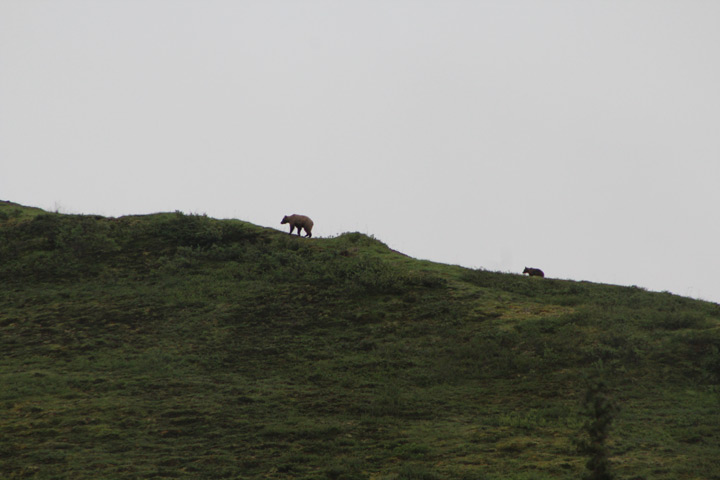
It was far off, but we did see bears in the wild at Denali.

Another brown bear trying to get his grub on. Denali.
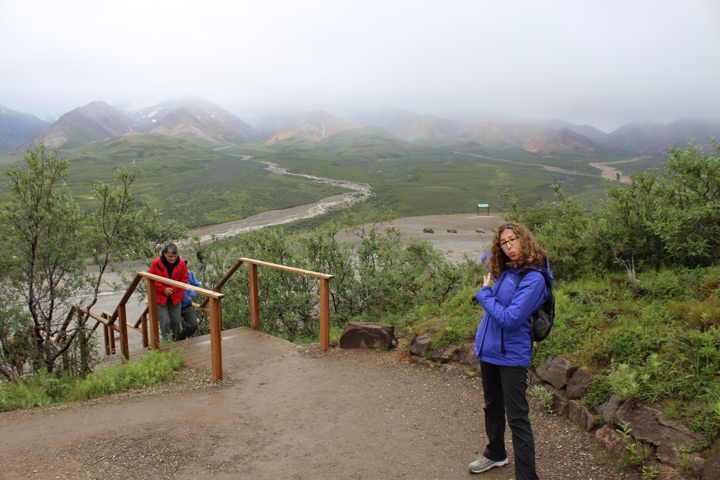
We liked what we saw of Denali! Which wasn't always that much ...
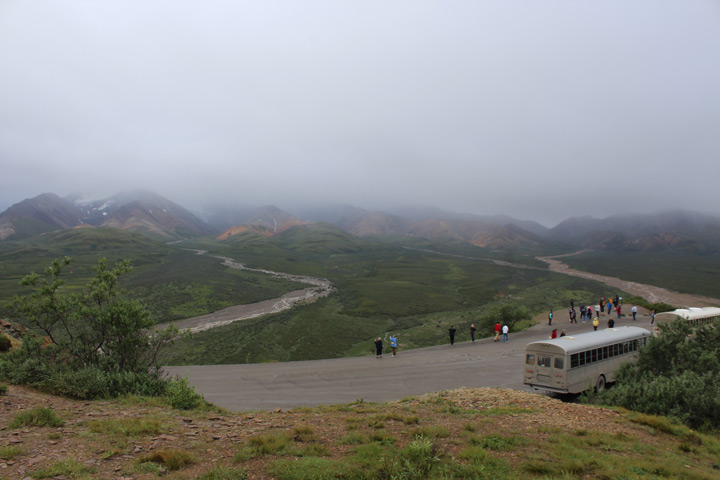
Denali gets sunshine two days per month and this wasn't one of them.
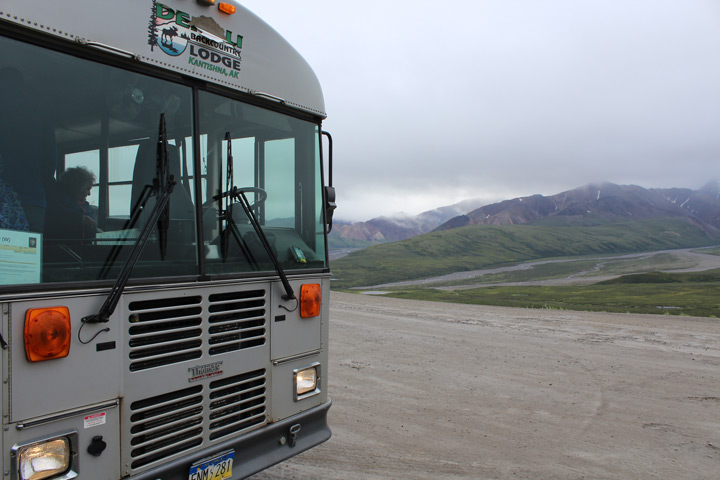
Our bus for the 90-mile ride into the park.
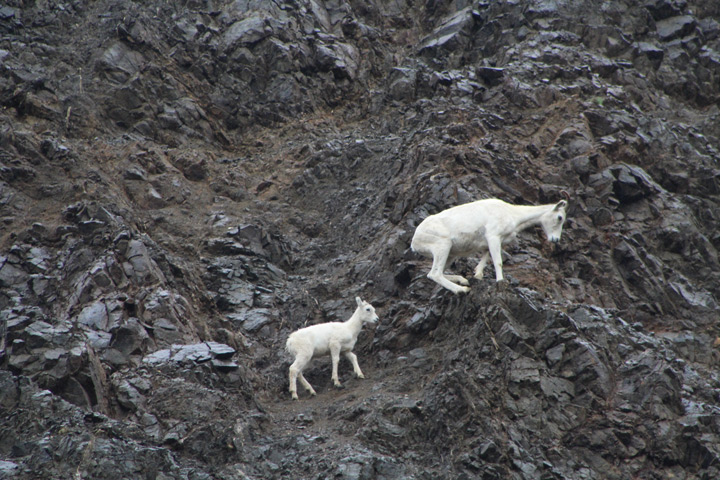
Dall sheep pick their way across a rock face, not far from the roadside.
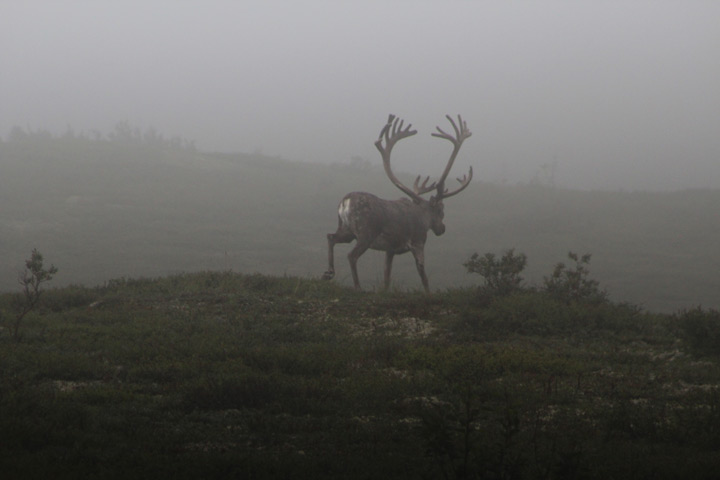
I think this is a caribou. Whatever it is, NICE RACK!
We also got to enjoy the beauty of the park, even through the mist. We saw up close the "braided rivers," silt-laden glacier-fed waterways that change their course from day to day. The rivulets diverge and converge endlessly. A few mountains poked out from the clouds now and then, but Denali itself was nowhere to be seen. A very helpful exhibit at the Eielson Visitor Center, 66 miles down the road, revealed that in the average July the mountain can be seen two days. Yes, a slab of rock four miles high disappears 29 days out of the month, because of the weather patterns caused by a 4-mile-high slab of rock. There is a panoramic viewing window at Eielson that most days gives you a great view of mist. There is also a helpful calendar recording the visibility from the last month. No matter what day you visit, the previous day will have been perfect, while it's zero visibility for the 10 minutes you happen to be there. They don't exactly emphasize this in the Alaska guidebooks and promotional material, which feature stunning shots of Denali against blue skies. You must need special training to work in Eielson during the summer, where every 30 minutes another wave of tour buses drops a bunch of disappointed people at your doorstep. It must take a particular kind of park ranger to stare hundreds of children in the face every day and assure them that hey, cheer up, the informational video is just great. (It actually is kind of great; the focus is on people trying to climb Denali, and what a pain in the ass it is. In terms of an actual climb, you can "walk" to the top of the mountain -- assuming the weather lets you go at all.)
After a few hours of pointing out dirty bus windows, we reached Kantishna. In the early 20th century, gold fever had people spreading all across Alaska, and a few extremely hardy souls decided to check out reports of gold near the base of Mt. McKinley. This was quite dumb on their part. Supplies were far away, while the weather and wildlife could be relentlessly hostile.
But their foolish sacrifice made our tourism possible. Kantishna is now the end of the park road, and there's a privately operated lodge where the tiny gold-rush community used to be. Our group piled off the bus to find a very nice buffet lunch waiting for us. A few other tour groups were mixed in, and this is where the stories were swapped. ("You saw a bear in the distance? How nice! We were two minutes behind you but we saw a family of bears cross the road three feet in front of our bus, juggling and riding tricycles!")
After that, we had a little time to kill. They provided some gear so that you could walk out to the nearby Kantishna River and pan for gold. Practically, this means loading a little bit of mud and water into a big, shallow plastic bowl, then pouring it out slowly as you realize that there is no gold left in this river, and that's why everyone left more than a hundred years ago.
Failing to pull a fist-sized nugget from the waters, we went for a quick "history hike" to the preserved cabin of Fannie and Joe Quigley. Joe was one of the first people to stake a claim in Kantishna, and Fannie was his comedically grizzled wife. She could hunt, mine, cook, wrestle bears, and spit with deadly accuracy up to 2,000 feet. And she didn't need no man! Meaning, at some point Joe left her. But she stuck it out until the 1940s for some reason, and her home is now preserved by the National Park Service so you can see how crazy people lived back in the day.
All this was just stalling, however, as we were waiting to be cleared for takeoff. The thing about driving all the way into Denali is that you also have to get out of Denali. For many people, that means an 11-hour round-trip bus ride. 90 miles in, followed by 90 miles out on the exact same road. The weather changes fast enough that you might have a different experience on the way back, and you'll certainly have more chances to see animals. BUT, you'll be sitting on a bus for half a day, with other people who will also be sitting on a bus for half a day, and you'll all smell accordingly. Allyson has a bad back and worse patience for being smelly, so we decided to cheat.
Kantishna, thriving metropolis that it is, has a small airstrip. Months before, we had arranged to ride into the park, then fly out -- weather permitting. And we really didn't know if the weather was going to permit. Flights hadn't been allowed for the previous day or so, but it seemed like the clouds were breaking a bit. As we were eating lunch, we were told that the flight would happen. Eventually.
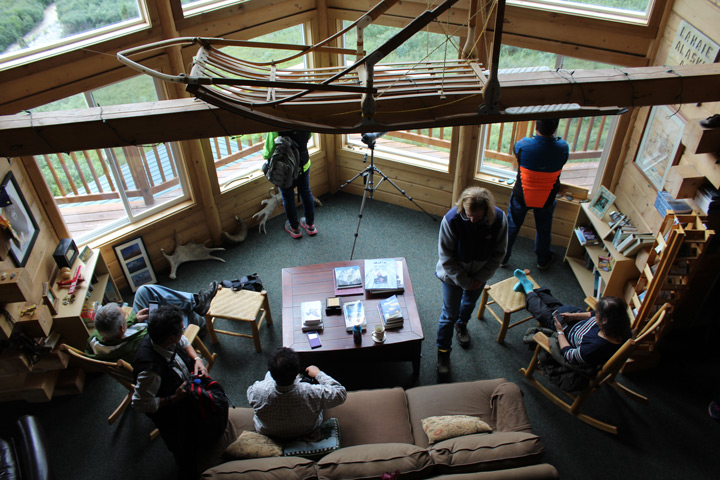
Waiting in the "terminal" of Kantishna Air Taxi.
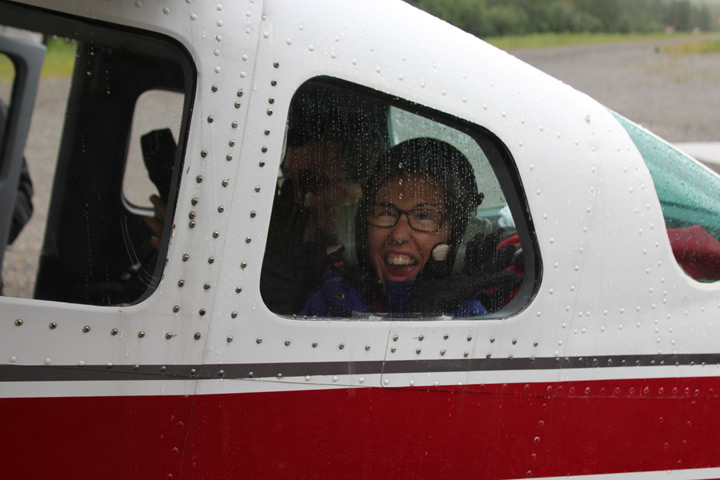
Gonna fly now ... ready for takeoff at Kantishna Air Taxi.
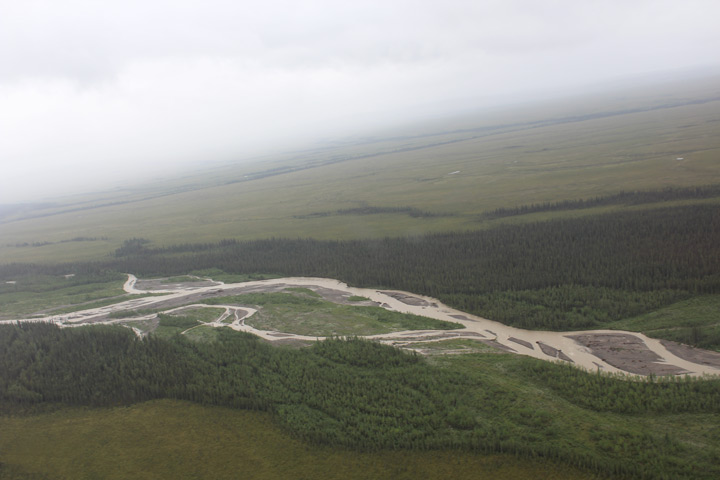
A "braided river" as seen from above.

The white block in the middle is the bus from "Into the Wild," still rusting away.
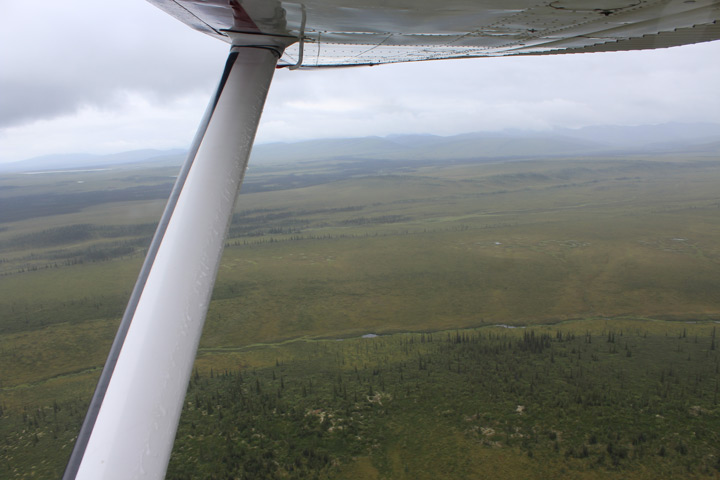
The tundra that makes up so much of Denali National Park.
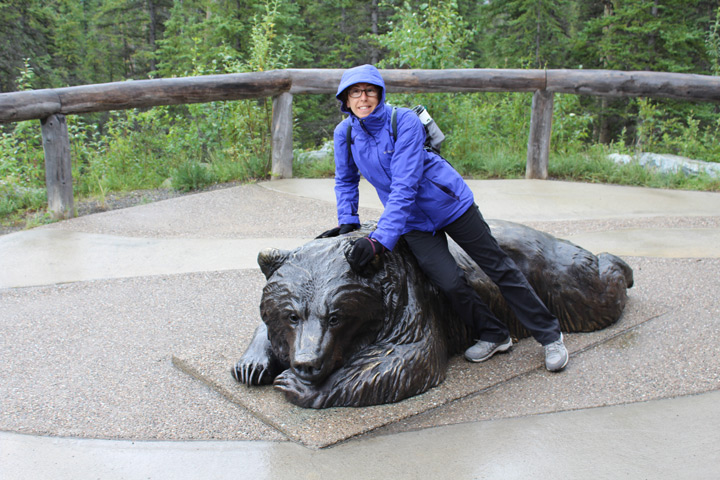
Back on the ground, grinning and bearing it at the Denali visitors center.
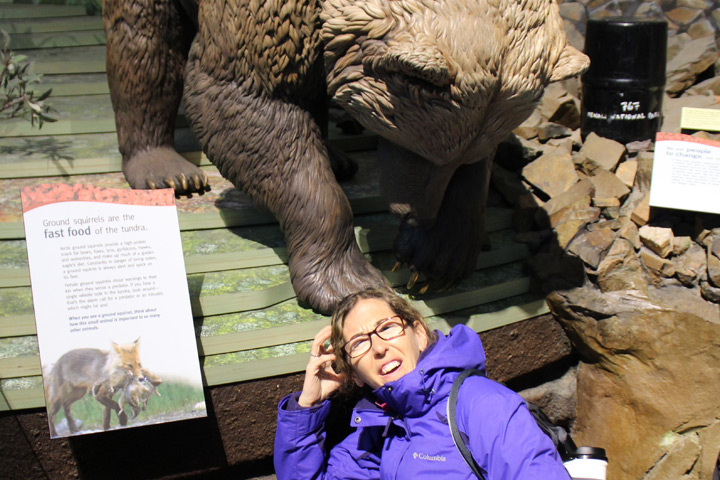
If you can't get close to real bears, fake ones will do.
Instead of getting back on the bus with the plebes, we hopped in a van for the short ride to the Kantishna Air Taxi headquarters. It's a very nice chalet on the side of a hill, with a very pleasant waiting area that seemed to be the opening of an Agatha Christie novel. There was a very peculiar bunch of Asian tourists camped out in one corner, none of them wearing shoes. There was also a conspicuous amount of waiting. Planes flying from Kantishna are small -- so small that you have to do the math as to how many people are flying, how fat they are and which side of the plane they're sitting on. We had reserved this in advance, but the air taxi service, in the interest of maximizing their profit, was accepting last-second bookings. Some very ... "high maintenance" women had decided that the bus ride back would be too much, and they HAD to fly on the same plane with their friends, so apparently we all had to sit around for an hour while this was sorted out. It was irksome.
But the flight itself was delightful. It was raining as we piled onto the teeny-tiny plane, which took six of us. As the resident heavy person, I got to sit up front and counterbalance the pilot, who was also an owner of the air taxi service. The clouds didn't lift, and we didn't see the mountain at all. But on the positive side, we also didn't crash into the side of it. Small planes are great fun, once you realize that no one on board is about to puke. Our pilot kept us below the cloud deck, giving us a chance to see the landscape from a new perspective. The tundra looks like a rolling green carpet, dotted with trees and bedazzled by pools and ponds. Braided rivers look way cooler from above. We spotted a moose, which looked less cool from above, but how often do you spot a moose from a plane if you aren’t Sarah Palin?
As we crossed the park boundary, the pilot flew us over the bus where Chris McCandless died. It's about 20 miles off the main road, in a small clearing close to some running water. Apparently it hasn't been moved. It continues to rust away, with the occasional adventurous hiker make a pilgrimage there. McCandless (or Alexander Supertramp, as he started to call himself) supposedly crossed a big river early in the season, then tried to walk back to civilization a few months later, only to find that meltwater and rain had made the river impassible. After that, he returned to the bus and starved to death. It was the opinion of the pilot and several other people we spoke to that this could only be taken as proof of Chris' immense stupidity. The river could have been forded at points a mile in either direction, after an easy walk. There are also some hunting cabins in the vicinity that were apparently broken into and ransacked that summer. The speculation by our pilot and others is that Chris did it, further complicating the question of whether he was spiritually enlightened or a jerk.
When we were back on the ground, a van took us back to our car, a few miles back down the road. We stopped into the park visitor center to look around. There we enjoyed some very nice taxidermied animals, small displays on park history, and lovingly made reproductions of animal poop. We were very tired after that, and a quick check of the Denali nightlife listings indicated that there still was none. So we had dinner at the Creekside Cafe and got to bed early. There was one last day of adventure to get ready for.
Day Fifteen
It has been noted in this journal that a big part of Alaskan tourism is picking different ways to get around while looking at the landscape. Two weeks into our trip we had been on kayaks, buses, big boats, little boats, tramways, a helicopter, a tiny plane, a dog sled, a zip line and our own feet.
I'm squeamish about white-water rafting, because one time when I was in Cub Scouts I fell out of a raft. I came nowhere close to dying but convinced myself that I was. For whatever reason, we decided to pass on ATVs this trip. Looking through the remaining tour options for the Denali region, we had a choice: horses, monster trucks or jeeps. You don't "drive" a horse on these kinds of excursions. They put you on the back of an animal that has done the trail a million times. The animal is indifferent to your existence and doesn't respond to your commands. They definitely weren't going to let us drive a monster truck, and we didn't want to be passengers after spending the previous day riding around on a bus and a plane. They will let you drive a jeep, so on our last full day in Alaska, we woke up to do that.
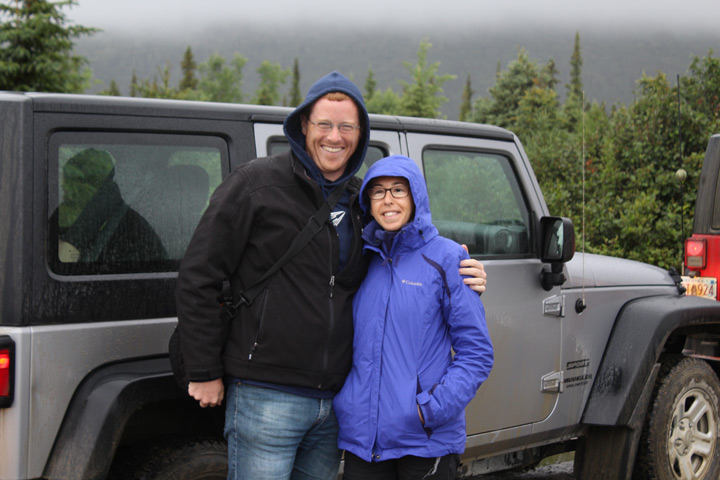
Ready to ride the (original) Denali Highway.
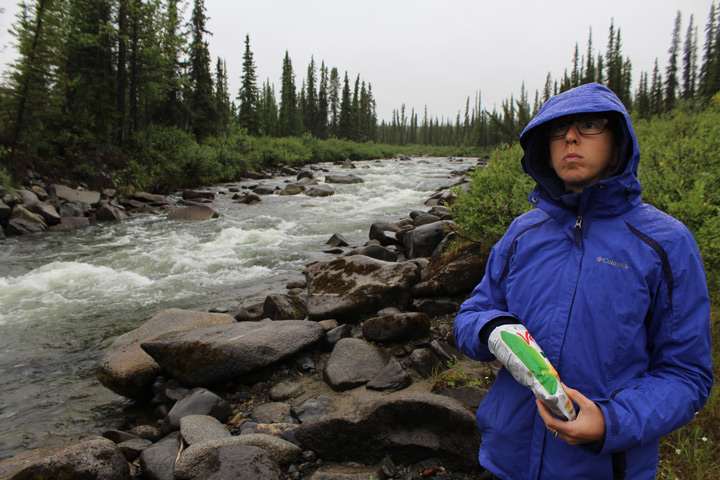
Contemplating the raging torrent while eating veggie chips.
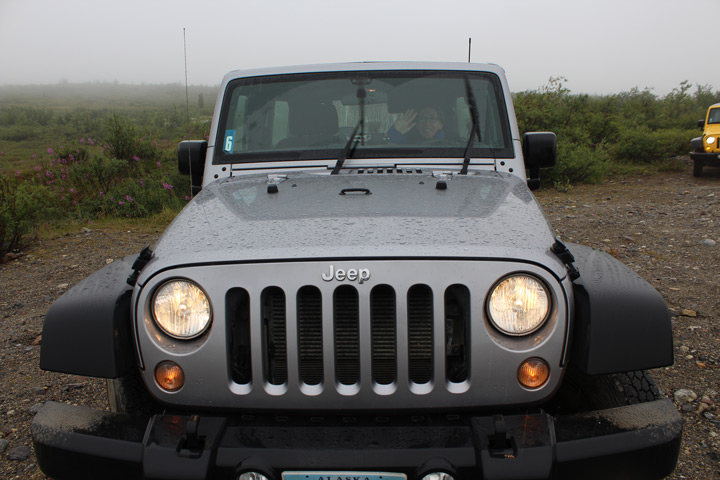
Behind the wheel of the Silver Fox.
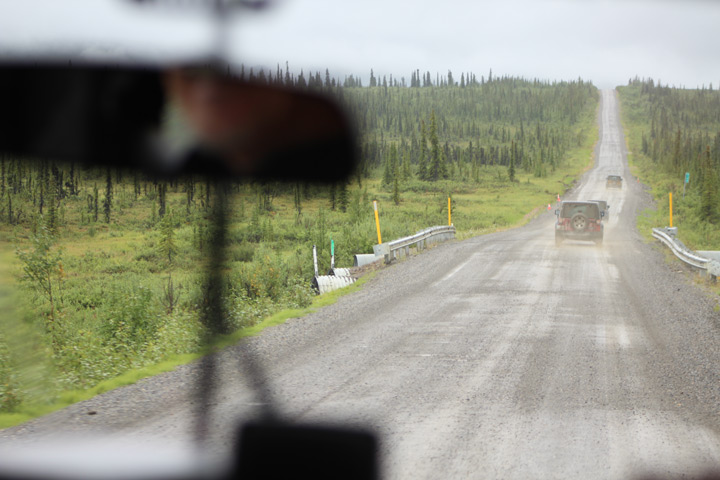
The Jeep convoy heads for home.

Great examples of "drunken" trees, caused by thawing permafrost.

A moose, doing its thing not far off a major road.
The original Denali Highway was completed in 1957, and at the time it was the only way to get to the park. It was effectively outdated in 1971, when the modern highway was completed -- the new one more directly links Anchorage to the park. But the Denali Highway is still there in all its Alaskan weather-beaten glory. It's not really paved in a lot of spots. But hey, we had JEEPS, and one of the most scenic highways in America was waiting for us!
The "home base" for the jeep outfit wasn't too far from our cabins, and our large group was divided into teams. They have jeeps of many colors, and we soon found ourselves attached to a car that shall forever be known to history as the Silver Fox. Our other team members were Greg and Cathy from Washington state. We went south to the town of Cantwell, reached the turnoff and headed east, racing toward excellent views of ...
Fog. The mountains around us weren't visible, and we saw very few animals. But you can make your own fun. We got to know Greg and Cathy a bit. They were an older couple that had been married four years; Greg was a nurse and Cathy was a teacher. Greg was also a former resident of Philadelphia, and he had worked as both a landscape architect and a commercial fisherman. Get to know your team members, people. Everyone but Cathy wanted to drive, so we swapped out several times. No one should be denied the excitement of driving an awesome offroading vehicle on a fairly well maintained gravel road!
But the most fun wasn't in driving. It came from the CB radios. Each jeep had one, and Allyson decided that the Silver Fox would be the king of the airwaves. We don't have CB radios at home. They were a new toy to play with in Alaska, and we like playing with new toys. When the guides asked trivia questions, we answered them obnoxiously. When children hopped on to tell corny jokes, we sometimes stepped on the punchlines. We kept referring to ourselves as the Silver Fox, over and over again, to the point where all the other cars probably hated us. Fortunately, Greg and Cathy were into this, or it would have been an extremely long morning. The weather didn't improve on the way back, but the guides were hard-working, the company was pleasant and the CB radios were awesome. It wasn't exactly the excursion we were imagining, but it was probably a million times better than riding on the back of a wet and smelly horse in 50-degree damp weather for two hours. The horses probably wouldn't have had CB radios, either.
Cantwell is south of the Denali park entrance. (Fun Cantwell legend: The sitting mayor was once arrested after being featured on "America's Most Wanted.") With half a day left, we decided to start our afternoon north of the park entrance, in the town of Healy. It's a coal mining town, and maybe the only year-round economic presence in the region. There's not really a downtown or a business district. But they do have excellent beer. 49th State Brewery looks like a roadhouse. The inside is a great space, with a cool wooden bar, an antler chandelier and a female mannequin riding a stuffed bear. We had a very good lunch with some very good beer, then headed to the parking lot to see the brewery's other attraction.
When Sean Penn was making "Into the Wild," they filmed a couple of scenes in the actual abandoned bush where Chris McCandless died. It wasn't practical to trash the thing for the sake of the movie, however, so they built a very close replica. And when the movie was done, 49th State acquired that replica and dumped it in their parking lot. It is decaying, just like the actual bus, but for now you're allowed to hop inside and see what the last days of Alexander Supertramp might have looked like. Let's just say he didn't die in comfort.
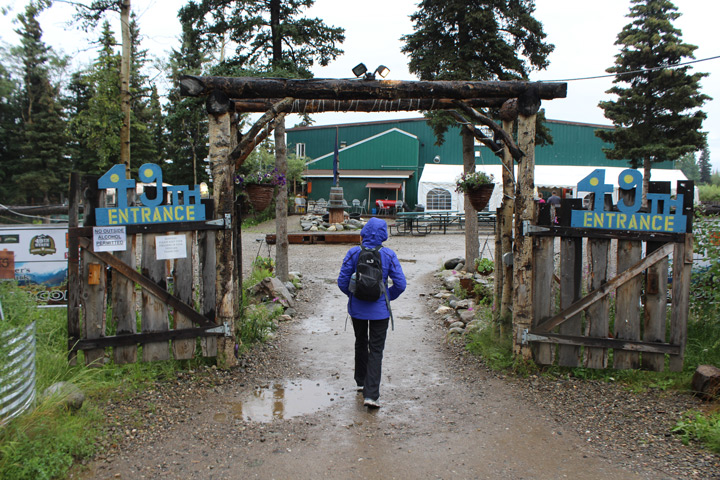
49th State Brewing, a fine place to get out of the rain.
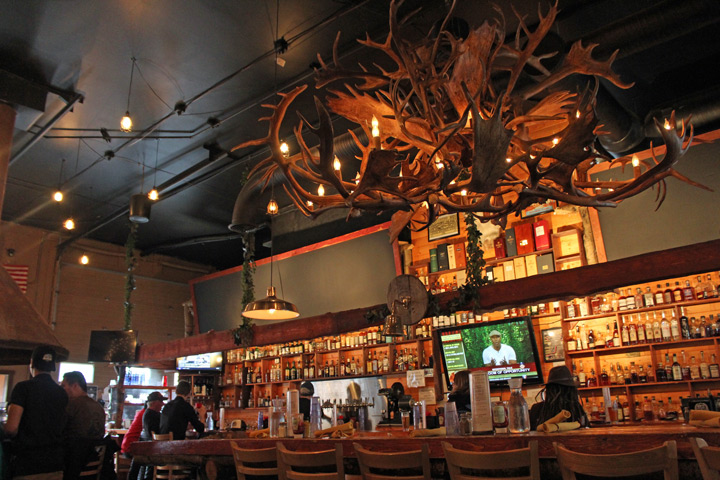
They Alaskaed the s*** out of the interior at 49th State.

In the brewery parking lot, the replica "Into the Wild" bus used for the movie shoot.
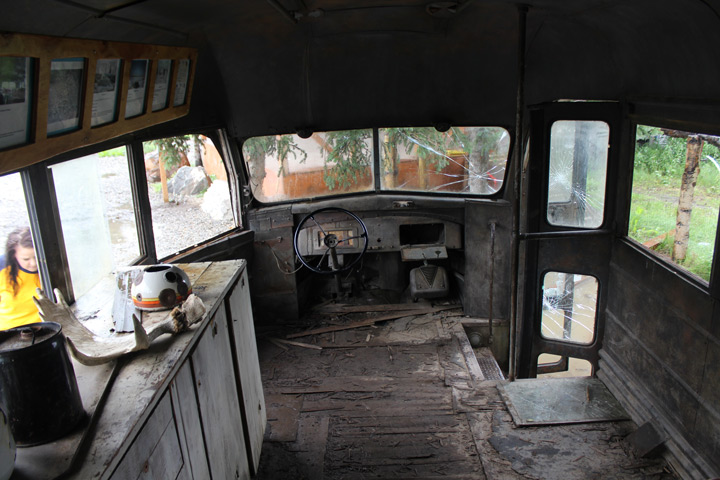
The movie approximation of Chris McCandless' shelter / tomb.
As dumb as Chris McCandless was, there must be a little Chris in all of us. We had checked off the requirements for a successful vacation, and it was drizzly and cool outside. But we had a car to get us around, lots of daylight left, and the hope that our trip might have a little more wildness left in it. We went back to the park one last time.
They let you drive 15 miles into the park on your own, so we did. The "free" road ends at the Savage River and a pleasant little parking area. There's also a trailhead, but the trail was closed ... due to bear attacks. A few weeks before we left for Alaska, there were reports of a bear attack in Denali. Naturally, everyone who spotted it online and knew our vacation plans forwarded the link immediately. People had been walking the Savage River trail when a grizzly approached. Ignoring all 5,000 of the bear warning signs he had undoubtedly passed to that point, one hiker decided to throw his backpack at the bear. There was apparently some light mauling involved, but the real upshot was that the bear acquired the knowledge that backpacks contain delicious food. Rangers tried to find the bear, but the bear pulled up stakes for a while ... only to return to the area a few days before we arrived. The park ranger with the very lonely task of guarding the parking lot told us all of this. The bad news was that we didn't get to hike that trail. The good news is that I can still tell myself that I'd be calm and brave if I had an up-close encounter with a wild bear. You can't put a price on self-delusion.
We followed that near miss with an actual animal encounter. Driving back toward the park entrance, we got our best look yet at a moose. There were warning signs all around the park visitors center that a cow was hanging out in the vicinity with two calves -- and that it would be insanely stupid to get near them or between them. We saw them scouring the brush maybe 50 yards away from the road, close enough to get some great pictures.
After that, it felt like we might have enough luck to squeeze one more critter into this visit. Emily, our hiking guide from a few days before, had mentioned a simple trail starting at the visitors center and leading to Horseshoe Lake. It was still drizzling, and not that warm. But the intrepid Allyson -- equipped with waterproof pants, a waterproof jacket, and her usual sense of adventure -- said we should do it.
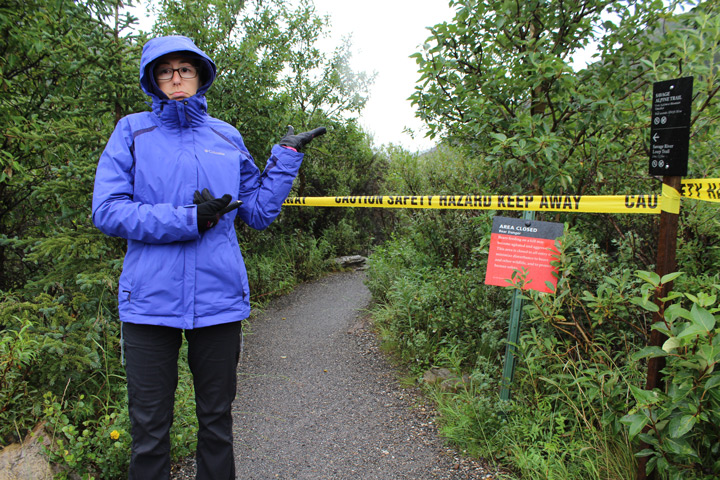
Back in Denali, a trail closed off due to a bear hunt.
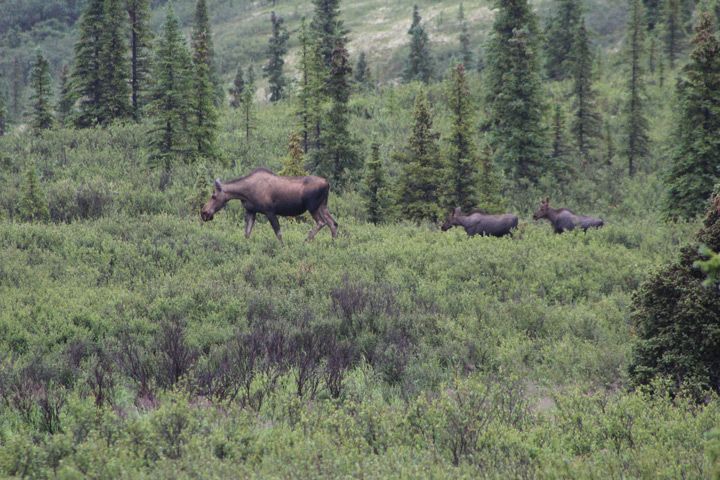
A moose family, on the loose!
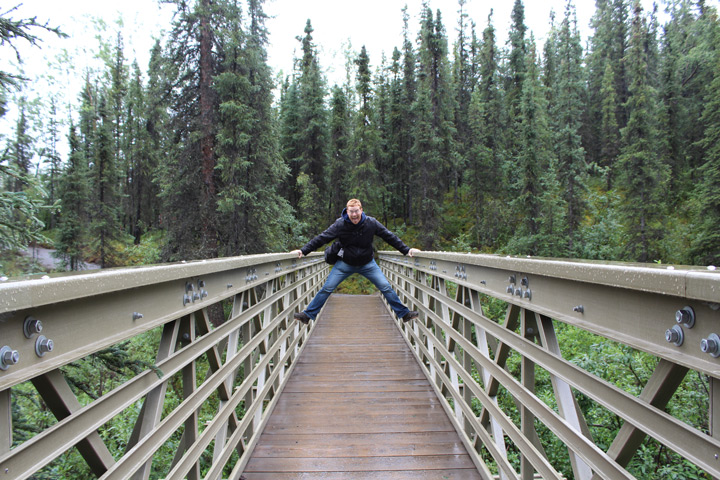
Getting punchy on the Horseshoe Lake trail.
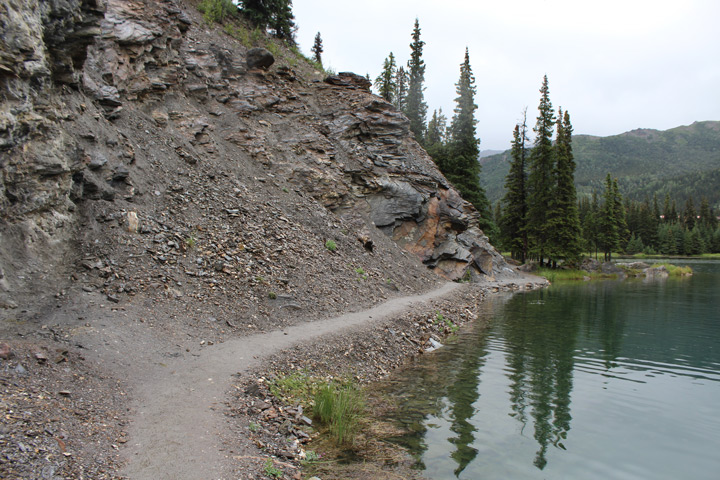
On the shore of very scenic Horseshoe Lake.
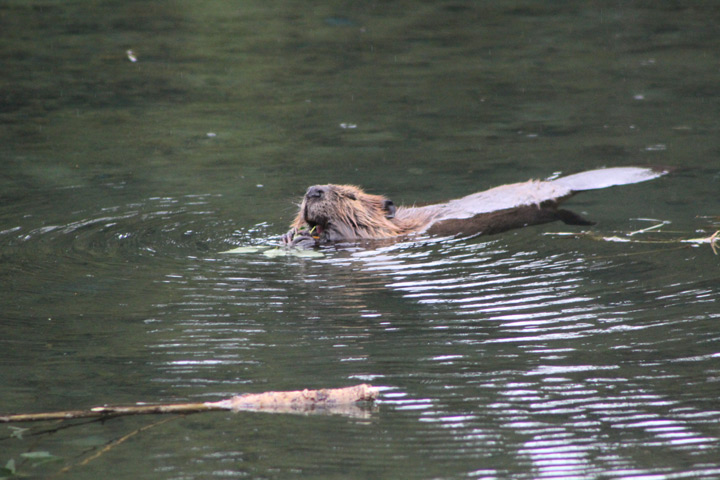
Bonus wildlife encounter: A beaver going to work at Horseshoe Lake.
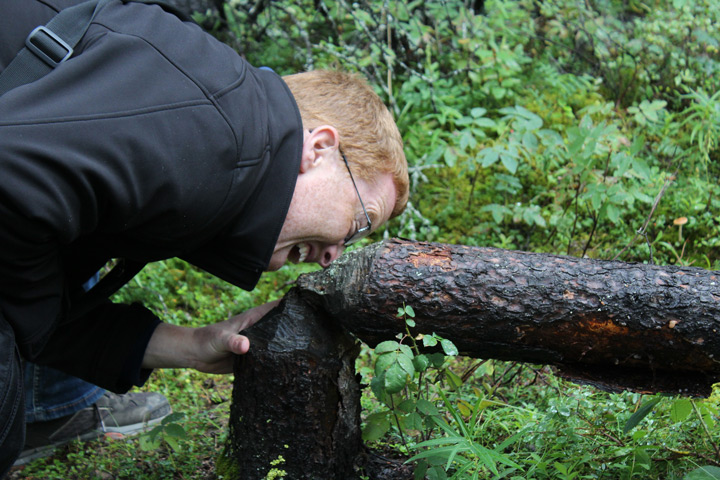
The key is persistence. Checking out evidence of beaver activity.

On our way out of Denali, one last animal buddy encounter.
The trail was mostly paved, taking us through some nice forests and over a few creeks. To pass the time as we walked, Allyson decided to play the role of "Ranger Jaffe," detailing the habits of the yahtzee bird, the feather bunny and the spider marf. (It's OK to get weird when you're alone in the woods.) As the trail started to slope down toward Horseshoe Lake, we passed a few people who told us they had just seen beavers hanging out there.
Beavers aren't exactly bears, and we have beavers at home -- lots of them, if you know where to look. But we hadn't seen beavers in ALASKA. We wanted to see beavers in Alaska, so we walked a little faster down the hill.
On the shore of the lake, we saw the evidence of beavers: Gnawed-off trees and a dam in the distance. But there were no beavers. We started walking around the lake, making our way to the edge of the dam. No beavers. We kept circling the lake, reaching the banks of the Nenana River and the park boundary. More stumps, but no beavers. We reached a second dam. There were drunken trees and dramatic rock faces, but no beavers.
It was nice walk, but the hour was getting late, so we decided to finish circling the lake and climb back uphill to the car. Then, miraculously, we saw a tree branch floating through the waters of the lake.
That was a beaver, doing the most beaverly thing possible. The zoom lens was called into action one more time, and we watched one of nature's cutest and most terrifying creatures as it tried to haul the branch over to one of the dams. Allyson named him Buster, because she enjoys naming things. We watched him for several minutes, basking in the glow of what would likely be our last wildlife encounter of the vacation.
We were wrong, because once we started walking again, within one minute we saw another beaver. This one was much closer to shore, and it was struggling mightily with a branch that was clearly way too big -- like me trying to finish appetizer nachos that are clearly meant for a group. We stopped long enough to watch the second beaver that another couple caught up to us. We told them about Buster, and they decided to name the new beaver Hunter. They were from San Francisco, and as Giants fans, they thought that the Posey / Pence combo would be fitting. They seemed like nice people, so I spared them a 40-minute speech on why the Philadelphia Phillies are the greatest baseball team of all time. They told us they had taken an Alaskan vacation 10 years earlier, walked the same trail, and seen a beaver. We made a date to see them, and more beavers, in 2026.
At this point nature decided to dogpile. We ran into some ptarmigans on our way back to the car. (They're the fat Alaska version of pigeons.) And as we were driving out of the park, almost exactly at the exit, we once again saw a moose with two calves. (It might have been the same one from before.) This was the closest we got to a moose in our entire vacation, and the experience was only slightly singed by humanity. A few girls had popped out of their car, and they were trying to get as close as possible to the moose to take cell phone pictures. It might have been fun to see the momma moose charge them, but then we'd probably spend our last night in Alaska filling out a ton of paperwork and giving chilling eye-witness statements to television producers. So instead I yelled at them to get into their car. Was I secretly hoping that the yelling might anger the moose? Hey, if literature tells us anything, it's that a few weeks in the Alaskan wilderness awakens the darkest parts of your soul. So, absolutely.
